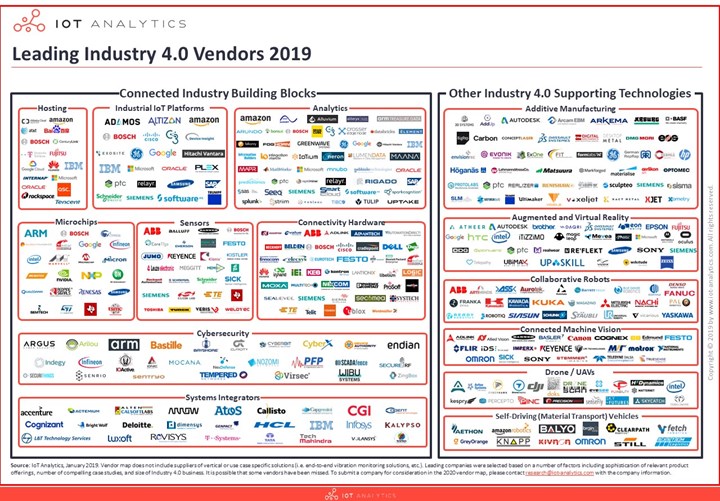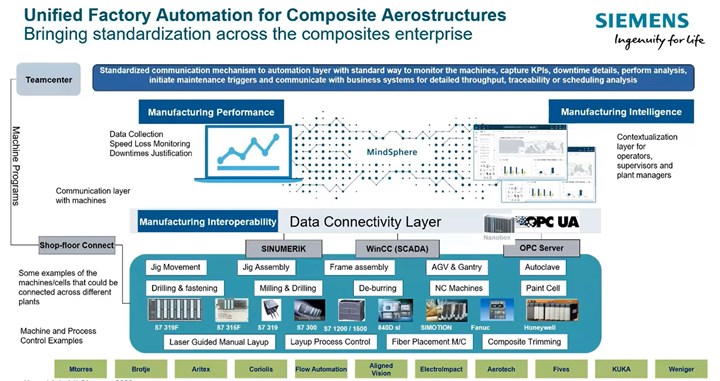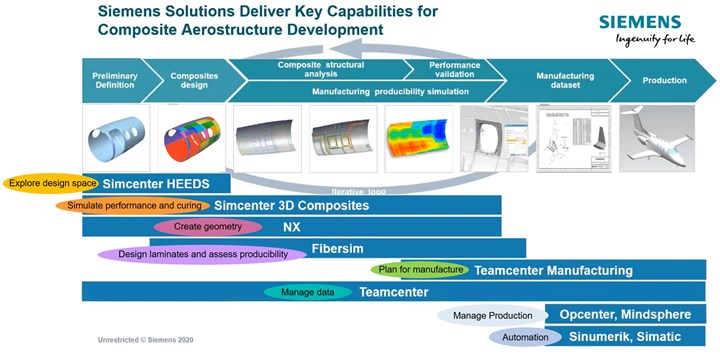Composites 4.0: Architecture and ontology
Adaptive systems, IoT platforms and apps, the need for 4.0 standardization and a new way to develop and certify composite aerostructures.

Source | IoT Analytics, Siemens Digital Industries, Plataine
This online sidebar shares visuals and conversations that wouldn’t fit into the July 2020 article, “Composites 4.0: Digital transformation, adaptive production, new paradigms”. Highlights include a preview of Swinburne University’s Industry 4.0 Testlab for Composites as I discuss the IoT platform MindSphere, and how a standardized Composites 4.0 ontology could unlock a whole new way to develop and certify composite components and whole aircraft.
Moving from top-down to self-adapting
Industry 4.0, or the fourth industrial revolution, is often described as the trend of integrating cyber physical systems into manufacturing. The goal is data- and intelligence-driven production that is more efficient, faster, cheaper and more flexible. “We are working on the technology bricks and linkages that are necessary for Composites 4.0 process chains now and process networks in the future,” says Dr. Michael Kupke, head of the German Aerospace Center (DLR) Center for Lightweight Production Technology (ZLP, Augsburg, Germany).
Today, says Kupke, we have hierarchical systems that use enterprise resource planning (ERP) and manufacturing execution system (MES) software to manage automation technology (e.g., sensors, actuation, control) on the production floor. “We are progressing toward more digitization and integration,” he adds, “but the vision for Industry 4.0 is production that is self-adapting and self-organizing.”
“It’s the difference between a system that is planned top-down, versus one which is self-adapting,” Kupke explains. “Top-down systems are very rigid and slow to react. If you have mistakes in planning, you have to re-plan all the time, compared to 4.0 systems, which are decentralized and self-planning, extremely flexible and able to quickly re-organize themselves.”
Source | Keynote for 2019 Colloquium on Production Technology, “Digitalization and Production” by Dr. Michael Kupke, DLR Center for Lightweight Production, adapted by CW
“To go in this direction, to get to Composites 4.0, you need autonomous production systems,” Kupke contends. “To achieve these, you need automation technology , sensors everywhere and software based on AI, to analyze and use all the data they produce. You develop modules to achieve specific functions [e.g., materials handling, curing, etc.] and let each module connect to any other module to create a self-regulating system.”
An example of this type of system is the automated work cell that ZLP developed as part of the PROTEC NSR project to build a family of parts that follows the same process route using dry reinforcements, pick and place layup and resin infusion. Using collaborative robots and artificial intelligence (AI), the work cell can switch from producing composite rear pressure bulkheads to fuselage panels without requiring reprogramming or retraining (see online sidebar “No business case for teaching robots”).
Swinburne Industry 4.0 Testlab and MindSphere
I was first introduced to the world of industrial internet of things (IoT) platforms through the announcement that Swinburne University of Technology (Melbourne, Australia) is establishing an Industry 4.0 Testlab for Composite Product Automation which will use Siemens Digital Industries (Plano, Texas, U.S.) cloud-based IoT platform, MindSphere.
“The Industry 4.0 Testlab for Composites at Swinburne will provide a pilot-scale process to advance Australia’s manufacturing capabilities,” says Bronwyn Fox, deputy vice-chancellor of research and enterprise at Swinburne University. “Swinburne’s Testlab will demonstrate the features of digital composites production in an immersive environment. The pilot-scale processes will be digitally controlled from part design and optimization through to the finished product. We will also create a digital twin of the process and push the boundaries of virtual commissioning.”
In her technical paper, "An Industry 4.0 Approach to the 3D Printing of Composite Materials", Fox explained that MindSphere will enable equipment from a wide range of manufacturers to communicate with each other. This paper describes how the Swinburne Industry 4.0 Testlab will function:
“Sensors … will enable each stage of the production line to collect a large amount of process data. This information will be stored in a secure local cloud and will also be used immediately to feedforward and feedback production data to other machines in the line, thereby enabling a self-adapting production process.
The proposed line ... is designed to allow product inspection after each stage of the manufacturing process. The inspection data will also be stored in the local cloud. Analysis of the large datasets stored in the cloud may lead to the discovery of new and unexpected correlations between the state of the finished product and the parameters of different stages of the manufacturing process, which in turn may be utilized to optimize the product.”

Pilot-scale production line for Swinburne University’s Industry 4.0 Testlab for Composite Production Automation. SOURCE | Swinburne University
Partners supplying key components include:
FILL (Gurten, Austria) has supplied the Multilayer system, which produces near net-shape stacks of precisely cut and oriented, unidirectional fiber tapes, up to 1.6 by 1.6 meters in size. The tapes are deposited from spools onto a rotating table, with a layer completed every 15 seconds, creating near net-shaped preforms that reduce scrap compared to textile processes. Fill’s Multilayer machine can lay up tapes of thermoset prepreg and towpreg, as well as dry fiber and low-temperature thermoplastic materials.
Langzauner (Lambrechten, Austria) has developed a high-temperature, automated press, with up to 300 tons of clamping force which will enable injection of resin into dry preforms, followed by cure, or compression molding when using thermoset and thermoplastic prepregs. Dielectric cure monitoring will enable shortened cure cycles based on real-time Tg evaluation (see “DC dielectric sensors for industrial composites production”).
Plataine (Waltham, Mass., U.S. and Tel Aviv, Israel) offers Industry 4.0 software for composites manufacturing that enables tracking of tools, parts and raw materials, creation of digital twins and analysis of machine sensor data to optimize part production.
CIKONI (Stuttgart, Germany) has supplied the DrapeWatch system for inline inspection and digitization of both preforms and consolidated parts. This robot-based 3D analysis system can identify gaps, misalignments and irregularities. It combines a visual sensor for detailed surface inspection with an EddyCurrent sensor for internal defects and in-depth material analysis. The system uses Artificial Intelligence and an interface to finite element analysis (FEA) to evaluate defects’ impact on part performance. The modular system can also be extended by integrating thermography, ultrasonic or laser scanning devices.
Platforms and apps
“MindSphere is only one of many IoT platforms,”explains Avner Ben-Bassat, president of Plataine, an IoT software company that specializes in manufacturing and composites. “The Industry 4.0 ecosystem is much larger than MindSphere and Dassault Systèmes 3D Experience [used in the ZAero project, see “ZAero project update”], but also includes companies like SAP, Hitachi and Bosch. There are actually numerous systems and applications,” he notes. “There is also a middleware backbone, providing a wide array of solutions with a lot of breadth, but not much depth. Siemens and SAP are not thinking composites or aerospace; They are thinking of how to apply broadly to everything, so most of these solutions are quite generic.”
Source | IoT Analytics
“All of the platforms are slightly different, and each has a different focus, also driven by the vendor’s core business,” says Ben-Bassat. “For example, Bosch is more hardware-centric while SAP is more software-centric. Siemens has both.”
According to Siemens, MindSphere’s share of the market is growing, with roughly 500 apps that it can accommodate. “You use different apps to solve specific problems,” Ben-Bassat explains. “Plataine is not a platform, but we are able to integrate our software into these platforms. However, most of our customers don’t use any of these platforms, as they have yet to take a dominant place in the market.”
“We offer our apps as independent and designed them using a microservices architecture for this purpose,” he notes. “You can run our apps on an IoT platform or you can easily integrate them at the server level or user interface level. We wanted to be ready for the different implementation levels. However, our apps are always connected to something, for example, existing ERP, MRP, MES systems or an IoT platform, etc.” Ben-Bassat notes that Plataine is a partner with Siemens, “So, we do have an opportunity to integrate with MindSphere.”
Visualization of how MindSphere can enable Composites 4.0 production of aerostructures. Source | Slide 47 from Siemens on-demand webinar: “Industry 4.0 for Composite Aerostructure Development”
The need for Composites 4.0 ontology
Ontology is a kind of standard terminology and common basis for digital communication and data exchange, explains Marc Fette, Chairman of the Technical Division - Aerospace Technologies of The German Association for Engineers (VDI). Fette is also COO for Composite Technology Center (CTC, Stade, Germany), an R&T subsidiary of Airbus. Why is ontology important? “For example, there are hundreds of machines and production systems in an aircraft production plant, but each has a different protocol for its electronic control system and communication. However, to achieve Composites 4.0, we need a common basis. Especially in composites, there are a lot of specialized machines. Each machine builder has its own protocol/communication platform. So, trying to digitize doesn’t work, or at least not in an efficient and sustainable way. You first need ontology – a terminology for digital communications. You need to make a holistic networking for all the machines and production systems in a production plant. This must also extend to engineering and logistics, including materials, processes and their certification. But this requires a kind of basis for digital communication, adaptable interfaces and data exchange. It is also important for writing the specifications when purchasing new machines and process lines.”
But Siemens claims it can provide software for every part of the 4.0 transformation. Doesn’t that provide a common basis? They show, in essence, that you can have everything talk to each other throughout horizontal integration (digital thread – development chain) by staying within a Siemens ecosystem/universe.
Source | Slide 51 from Siemens on-demand webinar: “Industry 4.0 for Composite Aerostructure Development”
“CTC is working together with a lot of partners in the field of IIoT,” says Fette. It’s possible to get smart solutions from companies like Siemens, Plataine and SAP, etc.; However, not all machines and production systems can implement these new control systems and machine interfaces. You must find new solutions to get these entities into this network. Or, you can build a new bespoke solution, but that’s expensive.” Hence, ontology, sustainable flexibility and adaptable interfaces have to be taken into consideration for new investments and also for updates in existing production lines.
Fette notes that there are a lot of Composites 4.0 pilot projects, “but when you look in detail, there is still a lack of strategy for a holistic approach per company or production chain. We have done a pilot project with Plataine for material & asset tracking and with our 3D Hub where we have interfaces with design methods. We are making advancements in technology and economics.”
New way to develop composite structures and aircraft
“To make an economic assessment,” he continues, “we evaluate a whole new production scenario for a composite component, for example. So, we are now picking critical cases to show ROI (return on investment). Then, we use the digital twin of the product and production scenario to realize a digital front-loading process [greater amount of work done at the beginning] for the overall development, and make improvements on the theory of the process. In the development phase, where we are now, we are using this to shorten development time and reduce cost to get to series production.”
“To give an example,” says Fette, “we have projects looking for new structural components using new composites materials, processes and building concepts. Often, these are totally new technological approaches — new hardware, new design and simulation methods, new assembly processes. First, we create a digital twin of the product and also of the future production scenario. So, again you need common ontology. We have shown that we can create this, not just in CAD but using a whole range of simulation to reduce time and cost to come to aerospace-certified subcomponents, components and assembly. This enables us to make a real assessment on the production line and possible rate increase, etc. Afterward, we can adapt digital twins for product and process improvement.” He emphasizes that this is not a pilot program, but occurring within real R&T development projects.
“This is a part of a possible future way to develop new aircraft components or new aircraft,” Fette points out. “In the future, each OEM will have to bring it together for all of the parts, for all aircraft and for their whole value chain, including the suppliers.” He also sees the potential benefits of digital certification. “You could use digital twins and their digital thread for a kind of digital certification to reduce the cost and time of certifying components and aircraft, and also to reduce the iterations required,” says Fette. “This is also a big research stream where the aerospace companies and organizations such as the German Aerospace Center (DLR) and EASA (European Union Aviation Safety Agency) are working to explore how digital twins and interactive materials databases can be used in certification. The goal is to reduce certification efforts and the amount of data every aerospace company is now developing individually.”
Related Content
Materials & Processes: Composites fibers and resins
Compared to legacy materials like steel, aluminum, iron and titanium, composites are still coming of age, and only just now are being better understood by design and manufacturing engineers. However, composites’ physical properties — combined with unbeatable light weight — make them undeniably attractive.
Read MoreThe state of recycled carbon fiber
As the need for carbon fiber rises, can recycling fill the gap?
Read MoreMaterials & Processes: Fabrication methods
There are numerous methods for fabricating composite components. Selection of a method for a particular part, therefore, will depend on the materials, the part design and end-use or application. Here's a guide to selection.
Read MoreThermoplastic composites welding advances for more sustainable airframes
Multiple demonstrators help various welding technologies approach TRL 6 in the quest for lighter weight, lower cost.
Read MoreRead Next
Composites end markets: Energy (2024)
Composites are used widely in oil/gas, wind and other renewable energy applications. Despite market challenges, growth potential and innovation for composites continue.
Read MoreFrom the CW Archives: The tale of the thermoplastic cryotank
In 2006, guest columnist Bob Hartunian related the story of his efforts two decades prior, while at McDonnell Douglas, to develop a thermoplastic composite crytank for hydrogen storage. He learned a lot of lessons.
Read MoreCW’s 2024 Top Shops survey offers new approach to benchmarking
Respondents that complete the survey by April 30, 2024, have the chance to be recognized as an honoree.
Read More
























.jpg;maxWidth=300;quality=90)









